 There’s an old adage that goes ‘too many cooks spoil the broth’, and Jesse V. Johnson’s latest action extravaganza, Triple Threat, comes loaded to the brim with cooks, and ones that can fight at that. Thankfully though, Johnson runs a tight kitchen, and against the odds the British stuntman turned director has delivered a dish that gives a plethora of martial arts talent their own individual moments to shine – amongst them Iko Uwais, Tony Jaa, Tiger Chen, Scott Adkins, Michael Jai White, and plenty more.
There’s an old adage that goes ‘too many cooks spoil the broth’, and Jesse V. Johnson’s latest action extravaganza, Triple Threat, comes loaded to the brim with cooks, and ones that can fight at that. Thankfully though, Johnson runs a tight kitchen, and against the odds the British stuntman turned director has delivered a dish that gives a plethora of martial arts talent their own individual moments to shine – amongst them Iko Uwais, Tony Jaa, Tiger Chen, Scott Adkins, Michael Jai White, and plenty more.
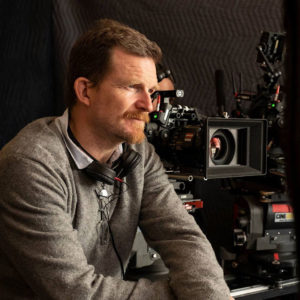
Jesse V. Johnson
So when the opportunity came up to interview Johnson, it was too good of an offer to pass up (and, in all honesty, I’d already made that mistake once with Accident Man). So it was I set about noting down the many questions I wanted to ask about the making of Triple Threat, and the inevitable challenges that must have come up along the way.
While it may pale in comparison to the rigours of making an action movie, my own challenge was that living in Sydney, Australia, meant that speaking to Johnson at his Californian residence on a Friday afternoon, involved me waking up at 6:00am on a Saturday. I’m not a morning person, even less so on a weekend. Thankfully though, any initial drowsiness was soon cast aside by Johnson’s infectiously energetic demeanour, and obvious passion for talking about all things related to the action genre.
Born in the UK, Johnson is the nephew of legendary stuntman Vic Armstrong (who also directed the 1993 Dolph Lundgren vehicle Joshua Tree). Like his uncle, he also started off in stunts (and continues to do stunt work to this day), however has gradually carved out a name for himself as a director. Initially gaining attention with his 2005 underground fight flick Pit Fighter, Johnson continued to work with the likes of Don ‘The Dragon’ Wilson on 2007’s The Last Sentinel, and Mark Dacascos on Alien Agent from the same year. However it’s his recent collaborations with British martial arts star Scott Adkins which have really put him on the map, directing the likes of Savage Dog, Accident Man, The Debt Collector, and the soon-to-be released Avengement.
Despite being limited to talking over the phone, Johnson’s enthusiasm for action, and his ambitions to deliver the best movie possible, are blatantly apparent. Prone to going off on entertaining tangents, and with a disarming humbleness around his own errors in judgement on past endeavours, his insights are never anything less than engaging. I also owe him a debt of gratitude for allowing our 30 minute timeslot to turn into a whole hour, and yet despite that, I was still only able to cover half of the questions I wanted to ask. I’ll save the rest for another time, but until then, enjoy the full interview below, which took place on March 8th, 2019.
* Anything in brackets denotes additional context.
* Note the interview contains a minor spoiler regarding the death of a supporting character.
Paul Bramhall: Hi Jesse, thanks for taking the time to speak to us! In the 10 years between 2005 – 2015, you made 7 movies. In the past 3 years, you’ve equalled the output of what previously took you a whole decade. Is there a driver behind this sudden burst in productivity as a director?
Jesse V. Johnson: You’re welcome Paul! Well I try to work as much as possible and I don’t like time off, so I’ll always be working on developing, lighting, shooting, or editing. What people don’t realise is that these films shoot very efficiently and quickly, a really long one would be 6 weeks, so that leaves a lot of time in the year for more shooting, editing, and what have you.
The development process on these films, in terms of the actual physical pre-production, is very rarely longer than 2 months, so you need to complete your casting, scripting, and everything else all in those 6 to 8 weeks, then the money drops and you have to start the principal photography. In terms of the editorial process, you’ll be supervising it say every couple of days, and then more frantically as it gets closer to delivering the picture. So my input as such will usually be that I’ve already started to develop another film during this process, or working on something else at the same time, because one film in today’s climate won’t be a yearlong endeavour, from start to finish you’ll be 6 months tops.
That final phase of overseeing aspects like color correction and visual effects is not a full time job at all, it can take up 1 to 2 days a week, so that allows me to give my full heart and soul to 2 or 3 films a year. That’s the ideal process, because these type of films also don’t pay very much and come with a high overhead, so when you have a family and a daughter in film school who also wants to become a director, it becomes a matter of necessity to have multiple irons in the fire. In what you could call my prior career, it was very very tough to get films going, so I was very lucky and was working more than most of my peers who were also independent directors.
PB: Thanks for the insight! Of course in 5 of those 7 movies, you’ve been working with Scott Adkins. I’ve made reference in at least one of my reviews for your collaborations together, that it feels like you bring out the best in his performances the same way Isaac Florentine does. What I particularly like about your collaborations though, is that you utilise Adkins’ English accent the way it always should have been, and you don’t always feel the need to showcase his aerial repertoire. How would you describe your working relationship now that you’re 5 movies in?
JVJ: With Scott, I found myself in a situation with an actor who was like minded and who I got along very well with, and I believe we do good work together, you know we don’t let the other person get away with half assed stuff, so it’s good to have a partner like that who’ll look across to you and say, “that sucks”. I’ve never really had that relationship with an actor before. Equally, I’ll also look to him and say come on, I know you can do better than this mate, and I can say I’ve never been in a situation before where I’ve felt comfortable enough with a lead actor to talk to them that way. So the 2 of us really motivate each other and kick each other’s butts, swear at each other, and generally push the others level of work to the next level, quite often by the most basic means.
You know we’re both very blue collar, Scott’s the son of a butcher and my mother was a single parent school teacher, so we have a very basic way of working together that’s not highfalutin or intellectual. We’re like a couple of a cabinet makers who are polishing our technique and trying to make the best quality cabinets out there that look beautiful, well finished, and chosen with the best wood possible, and in and of themselves will someday hopefully be looked at as works of art. Right now we just really want to entertain and do stuff that, you know, is a little different.
Now of course this is a challenge as well, because the genre we’re in is not really a money making one, and there’s a lot of very very poor quality films out there, but also the people that watch these movies in the past 3 decades have now become avid video game players, and are no longer interested in going to the movies. So we have to shift the perception and realise that you can no longer get away with only having good fight scenes. You need to have that good story, you need to have some humor in there, you need to have outrageous action, and yes also violence if you want to move the needle in that direction, stronger female characters both protagonists and antagonists, and you know, just stories that are different and push the envelope.
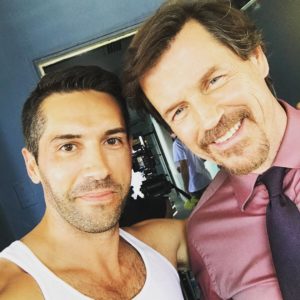
Adkins with director Jesse V. Johnson.
At the end of the day, you’re coming up with a film where 2 people need to hit each other in the face, and you have to come up with a valid reason for that. I mean I don’t know about you but I haven’t hit anyone in the face for a long time, since I was a teenager, and even then it was more silly than it was vicious. So you need to come up with a legitimate reason to validate that kind of physical interaction, and that takes some serious sitting down to think about, and when you watch a lot of action movies today you realise they haven’t taken that time to sit down, you know, there’s a reason a lot of these films don’t work.
So that being said, something like Triple Threat presented enormous challenges, we’ve got 8 or 9 high level martial artists that we want to give some time to, some really good time to, and we need to validate those moments with a story. Not only that, but we also need to highlight each of those unique marital styles, and the individual performers of those styles that have dedicated their lives to perfecting their craft. So the challenges are there, but I think as long as you take the time to be creative and are very careful with it, this can be a highlight of the genre.
PB: I think it is, and what was it like to work on a movie with this much talent and this many expectations?
JVJ: It’s exciting stuff making these movies, in the moment your heart’s in your throat a lot of the time, and being a stuntman for 20 years I’m very conscientious of keeping everyone safe, especially the cast and crew. But also the stunt people as well, you don’t want to hurt people, that’s not the challenge, the challenge is to make it look like they got hurt. But every once in a while you’ll have one stunt where there’s always room for error, so everyone has to be thinking, and as long as everyone’s thinking you’re good. But if you have just one person in the room, be that a stunt person or actor, that has a lapse of attention, that’s where things go wrong, and the more people you have in the room the more the odds are against you. But I will say it’s a very exciting way to make a living, voiding that risk factor and still making it look exciting.
It was a great challenge on Triple Threat and we had fantastic people. Seng (Kawee – the stunt coordinator), who’s a master and has worked with my uncle (Vic Armstrong) doing stunts on some huge huge movies and acted as a supervising coordinator. Kazu (Patrick Tang – the stunt coordinator assistant) was his right-hand man and did a lot of our hands-on stunt coordination, he’s phenomenal. The stunt team from Thailand where top notch, and then you have Tim Man whose very very good, he is doing more and more choreography now including his own, and Scott is particularly good with choreography and camera placement. Then you have Tony, who’s obviously like a walking deity, like a God on earth when it comes to knowing this stuff and his knowledge is incomprehensible. You know to have made all of the martial arts sequences look bad, we would have to have been doing something really really wrong, these guys are just so good.
PB: Before filming rolled, where all of the fights in Triple Threat already scripted, or was it a case of as more of the cast came onboard, you realised “we have to have these 2 guys fight each other!”?
JVJ: Such a simple question, but I’m going to give you a really complex answer! (laughter) I don’t have action written into my scripts unless it’s an absolutely key plot point. There’s nothing I hate more than “he threw a left hook & then he threw a suplex”, you know I don’t want to read any of that crap unless it involves the story in a certain way, otherwise its fine to say, “they fight, one of them wins”, you know keep it simple in the script. With this script, it was Joey O’Bryan who wrote the version that we took to Thailand, and then our local producer there Mike Selby and I obviously had to adapt it for Thailand and the actors as we cast. Joey didn’t know who or how many people were going to be in it when he wrote it, but the basic script is his and he did a very good job with that.
We had to at that point manipulate it to make it work for the environment, so we would write the plot points into the script, then very much leave it to Tim Man and the team to design the choreography. I would look at the set and say “Look I think they fight in here, moonlight behind them, keeping this side of the table in shot, and at that point, we’re going to kick Tony through the wall. That’s going to knock him out, which takes him out of the fight, and that’s the only way we can do this, otherwise he’s knocked out and he’s lying to one side of the set, and the audience is going to be continuously wondering why he doesn’t open one eye to check out what’s going on.” (laughter)
So things like that, I’ll have those conversations with Tim, and he’ll say, “You’re nuts, you can’t kick Tony through the wall, how’s that going to work!?” So I told him we’ll get this stuff that I know called pyrocell (a plaster made from foamed gypsum powder), and we’ll build some up so we can ratchet him through the wall which will look really violent, and that’s how we would come to an understanding. Then he’ll work the choreography based on my direction, and come up with the artistry. You know just as a dance choreographer or any other martial arts choreographer knows, you don’t want your first unit director doing that, it’s not what he wants me doing. He wants me dealing with the actors and dealing with the story, and he doesn’t want me spending my nights figuring out what kick works better, that’s the position of the choreographer.
So I oversee it, and I’ve done it dozens of time myself in shows like Walker, Texas Ranger, I’m very aware of what goes on and I’m fine with letting somebody else do it, especially when they’re of a very high quality like Tim is. He would design those fights, and the actors would then come in and look at his choreography and say, “No no, it’s Silat, it would be better if I took hold of his wrist and hit him with the back of my hand.” So Iko would say that kind of thing, and then Tiger would add his 2 cents, and you know for the most part they’re very onboard, because Tim has such a consummate sort of knowledge when it comes to fight scenes, he’d really given them interesting stuff to do anyway even before their input.
We used Mike Bisping very very well, surprisingly good at choreography, and you know I talked to him about it afterwards and explained normally I get real fighters and they’re a pain in the ass to choreograph. (laughter) So he said to me, “You have to remember Jess that, before I did MMA, before I did UFC, I was a martial artist, I had to do my sets the same as everyone else in order to get my various rankings and belts.” It’s almost identical to film choreography to learn some of that black belt stuff, you know you have to learn every single one of those sets, and people don’t realise that, there’s a tremendous amount of choreography that you have to remember.
So he was very adept at fight choreography, he got to do some really fun stuff as well, which was great considering I’ve had some disastrous experiences with UFC guys in the past. You know where literally their memory, because they’ve been pounded in the head so many times, was 1 or 2 or 3 beats then you’ll have to cut, then its monkey see monkey do for the next 2 or 3 beats, and it’s very limiting when it comes to choreography because every exchange is very short. Then you get to the inevitable point where they yell, “Just let me fight him for real!” But it’s not going to look very good because the stunt man won’t be expecting the hits, and they’re not going to look like very big hits because we don’t want him to be knocked out. Even the most gung-ho of stunt performers isn’t going to want to be hit by a UFC guy many times, so it can be frustrating.
Bisping was particularly good and I thought he did great, I really enjoyed working with him, I think we built a really good screen image with him, a really scary looking cat. I particularly thought him and Scott did well with their brotherly banter, you know a lot of that was kind of improvised and we had to poke them a bit off camera to make them keep going, and I thought Scott was very brave with all the names he called him. It got very colorful and I asked Scott if he wasn’t worried about insulting the hell out of him, and he said, “Naah, I’m a much faster runner than he is.” (laughter)
PB: I recall an onset photo that Scott posted, in which you were demonstrating how to stage a fall, and you’ve already spoken a bit about how you collaborate with the fight choreographer Tim Man. Can you talk a bit more about that, and how your relationship has evolved in the short period of time since working together on Accident Man in 2017?
JVJ: So Tim I didn’t really know and wasn’t familiar with his work at all until Accident Man. Scott made an enormous case to bring him in and allow him to be the choreographer, and I trust Scott immensely, he’s a very good judge of character, and he’s a hard working guy that wakes up very early, and there’s not too many people like that. So the fact that Scott was recommending him as the right guy for Accident Man meant a lot. Once we started working together, I found that he had no ego, which is absolutely what you require of your choreographer and action director, because they have to work so closely with the director, so if there’s ego issues it can cause challenges. I have an enormous ego because I’m the director and we have to have that, it’s part of the job description, and you don’t want those clashes, it’s just not something that you need.
Tim is one of those guys who’ll spend 2 weeks putting together a fight, then if I see the fight and approve it, but then let’s say onset I realise oh shit, we needs to cut a few seconds out of this, if I go to him and say sorry dude, we need to cut 30 seconds from this fight, he nods his head and does it, and there’s no kind of precious, “Oh my God this isn’t going to be good for my reel!” So there’s none of that kind of ridiculousness, he understands and he’s experienced, and yes he’s disappointed and I’m disappointed too, but these are scenarios we have to deal with every single day, almost every hour when you’re making a movie, you have to make these compromises, so to have someone like that is brilliant.
Beyond that, he’s very creative, very very knowledgeable, and very good with the actors, so they like him and they get along well with him, and he’s not one of those action directors who’s trying to impose himself upon them, instead listening to what they have to say and then working with that. He has this very calm and very quiet demeanour, and I have an enormous amount of respect for him. So I worked with him on Accident Man, then was offered the job of Triple Threat, so I’m sitting in Thailand thinking oh my God how the hell am I going to do this, the clocks ticking and we’re about to start filming. I made a very passionate case to have Scott come on and play the bad guy, because I knew I needed guys who had the moves and that we wouldn’t need to double, because that would take too long, and I wanted guys that were real kickers that could go up against real kickers.
It’s the worst thing in the world to have to shoot over the shoulders of stunt doubles and then come around to make it look like the actors have done it, you know just a horrible cheap cheap way of shooting action. So I made the case for Scott, and he was hired as the key bad guy, and he then made a passionate case for me to hire Tim Man, and was telling me, “You have to do this Jess, he’s the only guy who can do this for you.” Now when it comes to martial arts choreography there’s no one that knows it quite like Scott, period, end of story, and I get it as I’ve worked with them all. So I took his advice, hired Tim Man and it was the best decision we made.
He got straight to work, was shooting pre-viz’s in Finland which is where he lives before he even got on the plane, and then when he got off the plane I think we went out for dinner once, then the next day he was straight into the gym putting stuff together with the local stunt guys, who he knew because he’d worked there as a stuntman himself. He’s actually half Thai, doesn’t speak Thai but definitely knew Kazu and Seng, and all of our key performers which was awesome because they accepted him straight away. They liked his demeanour, as I said he’s quiet, and isn’t a screamer who tries to assert his ego over anyone, and he’s a world-class player.
I watched these pre-viz that he came up with which were extraordinary, they were really really good, and I think I made probably like 3 adjustments to the fights over the whole movie. I told him where I needed the guys to be, where I needed the men who they were fighting, what acting points I’d want to come in and film myself, and that was it. From there he did the pre-viz with the stuntmen, and the pre-viz with the performers themselves, who would give their 10 cents of input. Because obviously every performer has their own input which they want to put in, whether it’s his own style or a technique that they’re having trouble with, or if they know there’s something they can do which will look good on film. Tim incorporated those inputs into the choreography, then I watched the pre-viz’s again and gave him the thumbs up, and those were verbatim what we shot on the day and are in the movie.
So it was all pre-planned, it was all laid out, and he’s a terrific guy that I’d love to work with again because he’s one of the best, and he deserves an enormous amount of credit for this movie which I try to remember every time I talk about it. But you know once in a while I forget and try to take all the credit myself, then feel terrible afterwards. (laughter) Another great choreographer who I like to work with is Luke Fontaine, he did the choreography on The Debt Collector, and also worked on some of the choreography for the fight between Tiger and Bisping on Triple Threat. Fontaine is my choreographer in the U.S., and I took him to England for Avengement, so it’s good to mix it up because Tim’s not always available, Luke’s not always available, so I go to whom I trust and who I like and who I know can do the job.
It’s so important to have that trust, because when I first started out I gave a lot of people a break, people I didn’t know, and in the end it back fired on me, it didn’t back fire on them. So now I’m a lot more careful, and it’s sad to say because experimentation is good, but I can’t afford it on these budgets and these schedules. You have to be very very together and you have to approach it like a military operation. You go in and you only really have one shot at everything, and if you don’t set your explosives in the right place you get a damp squib, and the whole operation was a waste of time, so you have to be very careful with the team you put together. Did you enjoy the choreography?
PB: I did! Knowing the time constraints and the budget this kind of genre is limited by in the era we’re in, I thought some of the choreography that you guys pulled off was amazing. Especially considering we get some flashes of 2 vs. 1 brilliance, which is exceptionally difficult to choreograph even when you have weeks at your disposal. So for me it was a worthy representation of everyone involved.
JVJ: That’s great to hear, and you know these guys are fantastic, you watch what’s going on and you realise that you’re basically dealing with world class athletes performing at the very very top of their game doing stuff that, you know, you can’t do with actors. (laughter) They’re not qualified, they can’t do it, they’d look at it and read “a back flip into a split into a double front kick”, it’s impossible. This is Gene Kelly doing a dance routine at the very height of his abilities, and I hope people get that.
For me the fights are good, I think they galvanize in the third act, that’s when you really get your money’s worth to a point where you realise “Ok, this was worth my attending, this was worth sitting down and watching this film”. It works very very well and I’m very impressed by what Tim and the boys pulled off in there, and I mean they wrecked themselves doing this. You see the product of blood, sweat, tears, broken bones and noses, bruises, blood spilt on the floor of the stage, what you’re looking at when you see Triple Threat is the end result of that, not to mention the 20 years of learning their craft ahead of that. It’s a rare thing, and it’s such a shame that the audience these days is playing video games and that we’re not able to make more of these pictures. But we got lucky here, we got someone to finance it and we got it out there and it’s having a short run in theaters so I’m very very happy.
PB: There’s plenty of fight action on display, but I wanted to talk about one standout stunt in which Adkins, or his stunt double, launches himself onto the front of a car while it’s moving. Can you tell us about how the scene was achieved, and how as a professional stuntman you mitigated the danger of it?
JVJ: Yeah, it was an absolutely hair-raising sequence in every manner of the word. We were in a very narrow street with cars and potential stabbing instruments everywhere and all over the place, and it was, you know, a dangerous stunt. There was a double involved, the jump itself was Scott, the impact of the hit was probably, probably a double, I won’t go into too many details. The most exciting thing from that day, I’d say my standout anecdote, was that we had a stunt double for Celina Jade. Now her sequence was driving the car as Scott punches through the windshield, so we’d given him a special metal plating in the glove, Scott could probably punch though it anyway, but just in case we didn’t want him to break his knuckles or anything like that.
So we have Scott safety harnessed to the hood of the car, and we have a double for Celina who we’re going to be shooting over the shoulder of. When it comes time for the stunt performer, she gets in the car, looks at the gearbox and looks at me and the producers, and says “I can’t drive stick.” Well I mean we absolutely panicked, because we suddenly realised we’d shot all of the sequence except for this one insert which means that, without that one insert of having Celina driving it and having Scott punching the windshield, it literally didn’t work anymore. It would look funky and look like something we put together in the edit room, so Celina Jade overheard this, walked over and said, “I can drive a stick, I’d love to do this!”
Now everyone onset was like, “No we’re not going to let an actress do this”, and of course since then we’ve heard the Uma Thurman story, these horrible stories, but she insisted, “No no, I’m serious and I’m qualified, this is something I can do, let me do it.” So, you know, we had the stunt coordinator drive with her for a bit, and when they came back he was smiling and said, “She’s a better driver than I am.”
So we put her in the car and put some goggles on, and she drove that car like a fanatic. We’re going about 20 miles per hour, not terribly fast, but it looks a lot faster than it is because the camera is inside the car. Regardless, at 20 miles an hour with Scott attached to the hood, if you make a mistake you’re going to hurt him very very badly, and that’s nothing anyone wants. So Scott punches through the windshield, she slowly pulls over to the side, we cut camera, and the shot was done. So when you see it in the movie that’s actually Celina driving, and she’s awesome, absolutely phenomenal. You know she’d come to me every morning with lines and she’d say, “I was thinking about this part of it last night, and I’ve made a few suggestions”, then I’d look at it and be like “Well, fantastic, yes actually let’s go with this.” (laughter)
It happened every day that we worked, so she really created that character from scratch, built it, and made the character breathe. She’s brilliant, I’m a huge fan of hers and I hope she comes back for the sequel, I think it’d be a miss not to have her, and it’d give us a little more action as well. The big thing was not to have her as a damsel in distress, and while yes theoretically she is, she never acts like that and never takes on that role.
PB: Speaking of Celina Jade, she obviously shares a few Mandarin language sequences with Tiger Chen, and the opening minute of production companies and distributors also makes it clear that Triple Threat has at least partly been funded with Chinese money. With so many restrictions to adhere to in order to be granted distribution in China, how much did you feel the influence of the Chinese investment as the director, and were there any stipulations of elements that had to be in there?
JVJ: It was tricky. I delivered a film which we were all very happy with, including the producers, but then we heard that it hadn’t passed muster with the Chinese censorship group. Now it’s an independent body and has nothing to do with the quality of the movie, it’s whether your film ticks certain boxes with regards to nationalistic issues, and you know, that’s just the way it is if you want a film released in China. So we had to make some changes that would make it acceptable for them, because the film was semi-financed by a Chinese group, and that was part of the deal when I signed the contract to become the director – I was to deliver a film that would play in the Chinese market. I didn’t know how much of a challenge that was going to be, and it did become a little bit of a challenge in the editorial. We had to bounce backwards and forwards a bit, there were some additional shots added, and that’s just the nature of modern movie making, so I did the best we could.
I worked with some Chinese actors, and we put them into the film, and we tried to keep it still as entertaining and rip roaring a story that didn’t get too bogged down, but still managed to satisfy those guys. So I heard that we passed, then we watched the film, and I was satisfied that it still had enough of me in there that it was acceptable, and you know I’m very happy with the movie. I think those moments skip by relatively quickly, and everyone’s aware of them (laughter), and that’s just as I say a part of modern movie making, where certain things sometimes have to be addressed. So do you fight against that? You can if you’re powerful enough, but if it means not getting the film released in China or having someone else take over the editorial of your movie, then you are probably making a mistake.
So these are the balances that you have to make. When I was first starting out in film, I had to hire producer’s girlfriends and wives, so I’ve done far far tricker things that I’ve had to get my head around to get a film made, it’s just a part of it. The artfulness comes in maintaining your vision while still being able to jump through those hoops, and to be honest, there’s always been a set of regulations that result in the best work anyway. The greatest artistic works where not born out of absolute freedom, never, I defy anyone to bring me an example, you know from the Sistine Chapel through to modern filmmaking. If you can point out a film where you think the director had absolute freedom that ended up being successful artistically, and I’ll point you out a film that had myriad restraints put on it that you simply don’t know about, from the likes of Sam Spiegel working with David Lean through to the Catholic Church and Michelangelo.
It’s always that set of boundaries that causes the artist to do his best work, because it forces you to work as hard as possible. The key for us, and I should say I’m not making any kind of claims to being like those guys, they’re geniuses, but my challenge is to make the best film possible within this framework, and still have it represent something that looks like it’s authored by Jesse Johnson. That’s the challenge, so you go out there and you do it, and if you don’t think you can you have to sign off that job and back out. So with this one I felt that we still managed to make, you know, a really bloody good movie. In many cases the fact that they were putting these boundaries on me actually caused us to use our wits even more, and come up with even cooler ways of addressing them, so I hope people enjoy it.
PB: Now while we’re talking about challenges, in previous interviews you described the hell of working on Savage Dog in the Vietnam jungle, and this time you were in the Thai jungle. Has the past 3 years made a big difference to the conditions you have to film in, or did you at least feel that the conditions in Thailand were less strenuous than Vietnam?
JVJ: Well let me say the nightmare that was Savage Dog was not about the location, I love travelling and I love locations that are arduous, you know the tougher and more dangerous the better. The problem with Savage Dog was that we hired a key crew member who said that he could deliver something, but who we found out very very quickly was absolutely unqualified for what we’d hired him for. You know, and this was basically the most key position on set below the director, and we realised that we had to replace him on the second day of filming. He ended up lasting until the end of the initial week, because when that particular crew member left, he also took all of his subordinates with him, you know the gaffer, the key grip, the assistants. So it became a matter of not only replacing him, but replacing about 15 people, and that was traumatic, the stuff he shot was just a nightmare.
So I tried my very best to move the camera and set up frames that would help, but you know I’m not a DP (director of photography). I tried to know where to put the camera and I chose the lenses, but I realised I rely very heavily on my crew, and we found ourselves in a remote location with the wrong man for the job. So the nightmare was watching this incredible cast that I’d put together being shot in such a way that it didn’t show them at their best. You know we had one scene with 6 guys in it, including Marko (Zaror), Keith David, Scott (Adkins) and Cung (Le), then when I played back the footage it was like, you know, something that had been shot as part of a student film. That was traumatic for me, but it was my fault ultimately because I chose the guy, he showed us his reel and talked a good talk, the price was right and he was bringing his camera.
I found myself being seduced by thinking I could do this cheaply and deliberately, and could put the money elsewhere on things like visual effects, more stunts, extra stuntmen. So you could say I was seduced by that opportunity, and I made a huge blunder, and that’s why you’ll notice that I now continuously work with the same crew members and cast who I know I can trust and I like to bring back. Now Jonathan Hall (the cinematographer), who I work with and have worked with on my past 6 or so movies is key, he’s such a great talent and such an incredible incredible collaborator. He’s brought so much to the table with Triple Threat, with Avengement, with The Debt Collector, with Charlie Valentine. The pictures that I’ve done with him are so head and shoulders over those that I’ve done with people I haven’t really been in sync with, so right now I’d be willing to take money out of my fee to make sure Jonathan gets his rate and turns up.
With Triple Threat I think he gave something really special to the picture, and I hope that people like it, but for my part I feel like he gave something very classic and something that really fits the cinematic form. You know we looked at Sicario an awful lot, and that was one of our guides for filming, so the camera should never be completely static, it should always be pressing either inwards or outwards, and just those kind of subtle techniques. I hope people notice that whenever we’re with the boys, the 3 heroes, it would be very organic with bamboo showing and everything is kind of held together naturally, with lighting coming from either candles or by funky old flickering lights. Then with the bad guys everything is very crisp and clean and metallic, so they’re lit by neon and blue gun metal colors. Jon just got that straight away, and he was very enthusiastic about bringing that look to the picture, and it’s done so well that it’s almost subtle, but you still feel it.
Now back to your jungle question. In Kanchanaburi, which is an elephant reserve about 3 hours north of Bangkok, it was beautiful, it was brilliant, it was fantastic, but man you have some problems when you’re shooting in the real jungle that you can never anticipate! The first one was that I was wearing shorts, so you have the entire Thai crew who are wearing long pants and boots, and I knew straight away I’d made a mistake. Everything there wants to eat you, cut you, sting you, or mate with you, so my legs were soon covered in blisters, sores, and cuts with things crawling all over the place that really shouldn’t have been crawling all over the place, but that aside it was a cool part of the shoot.
The hotel we stayed in was on the bank of the River Kwai, which is famous for where the Japanese had their prisoner of war camps, and the insects that came out at night to gather around the lights were just unbelievable, so there were a fair amount of screams during that night. It was during the first week of shooting, so a lot of the crew realised what they were getting into, even if that was by having to witness these 2-foot-long bugs and beetles, but for me it was quite exciting. When you’re in a jungle with a heavy canopy like that, it’s dark until 10:30 in the morning because the light has to be almost overhead to come through, and then its dark again by 3:00 in the afternoon, then you step out of the jungle canopy and its suddenly daylight again, so you’re like “What’s going on!?” So really you only have half a day of practical shooting time, but it was really fun, and you could hear the Predator music in your head as you’re walking around.
PB: It’s funny you bring up Predator, because I actually mention it in my review that the opening feels very Predator-esque in its setting and tone.
JVJ: Good! The sequence is a lot longer in the director’s cut, and we had a very similar score playing in that scene to the one by Alan Silvestri, and when the executive producers saw it they loved it, but they said you have to take that score off because it’s too evocative, so we went with their suggestion. But yes, I love Predator and think that it’s an enormously underrated film, you know because Arnold was in it it’s a film that’s been put in the category of all these other Arnold films from the same era, and while they were ok, they were very much just vehicles for him. Now there’s just something about Predator, it an incredible film that spoke to a generation of little boys, and it was the apex of that kind of film and storytelling.
You had this massive testosterone on display in Arnold that was so tough there was no one on earth that could take him on, so it had to be an alien. Of course the alien was equally brutal, with it stripping down to the waist to have its fight with Arnold, and it was just terrific Boys Own stuff that represents a cinema going audience which has vanished. Most of that demographic now are the ones that are playing video games, and they don’t come out and spend $15 to see a movie. So now you have to be smart, because those films are never going to exist again, the market has gone in which you could make a film of that size, with a studio like Warner Brothers throwing a huge budget behind it, and weeks to film.
My first film as a stuntman was Total Recall, and a lot of the crew on that had literally just finished Predator, so everyone was talking about it. Especially the shoot in the Mexican jungle, with the way everyone had to carry ammunition, including the crew, because there was so much of it, and I just thought that was so cool and wish it was something I could have been a part of. I had, I think it was my 17th birthday, just before starting on Total Recall, so I was a kid when they made Predator, or at least still in high school, and those kind of stories to me were just awesome. So yes, it was definitely an inspiration for that opening scene, at least when it came to the way we shot it, obviously the storyline is completely different.
We were trying to track down some tiger stripe camouflage that we could use in the jungle, because that was the camouflage that Jesse Ventura wore, and I thought it’d be cool if the boys were wearing that. But it was very tough to find it in Bangkok, and in the end they found one unique French special forces unit that had left some gear over there that we managed to get our hands on, so it was certainly fun. You know the big challenge was that I’d already made a film in Bangkok some ways back called Fifth Commandment with Rick Yune, which was, you know, an ambitious film. Editorially they re-cut it after my cut, which I felt was a total mess, and I don’t think they succeeded at all with what they intended, so I was very very sad when I saw the end result, but this happens when you’re a hired gun.
But the one thing I felt about Bangkok which you have to be careful with, and I’ve started to notice it with a lot of films that are shot there, like Bangkok Dangerous and Only God Forgives, and it’s that if you’re not careful, you get a very very samey look. It’s all asymmetrical, it’s all neon, the alleyways have tons of wiring hanging all over the place, there’s piles of tuk-tuks, so you can easily end up looking like a myriad of other films. In fact one of my daughters lecturers said to her, “If you’re not careful, and don’t listen carefully in this class, you’ll end up directing action movies in Thailand”, which I thought was hilarious, and she had a good laugh about that. But the truth is there are a lot of them that get made, and they do look very low budget, they look poor, they look scrappy, and it’s a very samey image.
So I sat and I talked with Mike Selby, and we listed the various different locations that we could go shoot in that would give something of a different look. This conversation included the jungle which was 3 hours away, so also involved an overnight stay in the hotel I mentioned for the cast and crew, but it was within the realms of reason for our budget. Then another location we had was this multi-million dollar polo club which had been built and never actually used, which is what we shot the final showdown in.
So there were a lot of different locations, including these old buildings that we were able to get into that had really interesting architecture, and it was just to really try and get a feeling of the story and not that you were constantly seeing the same 3 streets and buildings. Its unfortunately what can happen when you’re shooting in a major city sometimes, so we worked very hard on that, and that’s part of why it opens in the jungle and ends in the city. It allowed us to deliver something that’s as different as possible. Plus I really wanted to film in the jungle. (laughter)
PB: With all of the different locations used and such a talented cast, for you as a director, do you have a particular favorite scene or shot in the movie, and if so what is it about it?
JVJ: I think I like the third act the best, the big showdown at the abandoned polo club, but there’s one little sequence which I find very very fun, and I take full credit for it because I had nothing to do with it. (laughter) We were at the very end of the day and it’s the sequence where Celina and Tiger have to steal the police car, while the cop has gone to get himself a haircut, and there was a little bit of dialogue in there that Mike Selby and I had whacked out. Something about Tiger not being able to drive, so she would have to drive instead, and it was a bit clunky and a bit awkward, so then Celina said, “Oh we’ve got an idea, but can we do it in Chinese instead of English, because Tiger’s actually very funny and we’ve got this joke.”
Then they kept telling me about it, and they were so passionate about it that in the end I said ok, let’s do it your way, we’ll do it in Chinese but you’ll have to tell me where the punchlines are so I can give you coverage, then you’re going to have to help me edit it, because my Chinese is just down to “thank you” and “good morning”. So they were both saying, “absolutely absolutely absolutely!”, and they were so passionate and enthusiastic about this scene that we shot it in a third of the scheduled time we’d put aside to shoot it in. So we got it, got out, and I said to them, “Are you sure we got it?”, and they said, “Yeah it’s really funny!” So we watched the playback and it was perfect, and you know I had to go on a wing and a prayer because obviously I didn’t know what on earth they were saying until we added subtitles, and for me it’s probably the funniest beat in the film where he says, “I can’t drive, what are you talking about?” and they swap over.
So for me I just love that, I really really enjoy that kind of thing because you have to see the film so many times, and if it’s all simply come from my imagination then it can get tedious, but when the actors and everyone gets involved and alters their own moments like that it becomes an exciting thing. It becomes an adventure in and of itself making the film, so that’s possibly my favorite piece with the actors.
With the cast I thought Scott was very very good. I thought the way that he played it was really good, it was sort of a young mean Pierce Brosnan and he adopted that accent, which I think clicked for this film so I tried to give him as many moments as possible. I think Michael Jai White did well with some of the softer moments in this one as well, he’s got a really really good comic timing, and I’d love to see him do more of that sort of thing because he’s very good with it, he’s a good straight man. I enjoyed working with Michael Bisping, I’m a big fan of his, so it was fun to work with him and I thought he was a really interesting physical presence in the picture. Oh, and I did enjoy shooting the police station siege, which we had very minimal time to do but it was a lot of fun, and it really sort of got everyone into the mood of things. So overall a lot of favorite moments!
PB: Speaking of the police siege, it feels wrong to discuss it without mentioning Jija Yanin’s gracious exit from the movie.
JVJ: I know I know, poor little thing! That was written before we had Jija onboard, and it was originally a guy’s role, so it was a male character and then obviously once we found out that Jija was available I instantly changed the character to a female one, and we made her have that banter going with Michael Jai White which I found fun. But then we all realised, “Oh my God, Jija has to get shot by a grenade launcher, this is just awful!” (laughter) I mean literally everyone falls in love with Jija, she’s one of the coolest characters you’ll ever meet and very larger than life, eccentric, she eats an enormous amount all day long but is somehow still just, you know, tiny, and just has this incredible energy and tonnes of it. It’s bonkers.
So nobody wanted to kill her, Tony didn’t want to kill her, Iko didn’t want to kill her, he thought it was too much, but we had to stick to our guns because it was that little moment, that you know, that was necessary in the story. But, yeah, it was a little brutal wasn’t it?
PB: It was! It got my attention. It’s a shame because I think Jija has been largely underused ever since her fantastic debut in Chocolate, probably because it came at a time when Thai audiences had started to lose interest in the countries short lived action boom.
JVJ: Totally underused, and I don’t understand why, because she radiates screen charisma, and comes off the screen when you point the camera at her. She commits 100%, and I had no idea at all, but on that first take when she shoots the grenade into the room, there’s a huge explosion and it hit her right in the face, and I kept filming because she didn’t say anything. I watched it and she seemed to be fine, and as we were proceeding through the days filming, I noticed a welt underneath her left eye coming up, you know a really bad injury. So I said, “What have you done?” and she explained that it was the explosion, it caught her in the face when it went off, so we went back and watched the footage, and whatever it was it hit her so hard that it knocked her head right back, but not a word, nothing at all.
She didn’t even ask to see the medic, I had to force her to stand still so that the medic could check that there was nothing under the surface of the skin. So you know she’s very tough, and whatever it was singed her eyebrows and her hair as well, because there was that awful singed hair smell. (laughter) There’s a photo of me, and you can see I’m completely in my own world looking down trying to tell someone how to hold a gun, and she’s standing to my left, and if you look closely you can see the singe marks on her cheek and her hair, and I just think oh my God she’s tough. A really really cool cat to work with, and I hope she just keeps working and doing more and more stuff. I’d love to work with her again, you know maybe resurrect her as an evil twin sister, or her well behaved twin sister rather that comes back as a heroine for the second Triple Threat.
PB: Well if it worked for John Woo and Chow Yun Fat, so why not you guys?
JVJ: Yes, exactly!
PB: What can we look forward to with Avengement? From what I’ve read so far, it sounds like more of a character driven piece for yourself and Scott Adkins, which will be a change of pace to what audiences are used to.
JVJ: Yeah you’re right, but I mean there’s definitely violence and action in it, there’s certainly no shortage of that, but it is a very different film from what we’ve done before. Its book ended by a story that takes place in an English pub, with quite a lot of dialogue and explanation, and it’ll take people by surprise because it’s not what you’d expect at all. But the violence is definitely very real, and it’s definitely there in the film. I’d actually forgotten how much was in it, because I’d been thinking my God, you know I’ve made this talky movie, and then we watched it when we had 2 screenings in L.A., and it does actually have a lot of violence in it, I just sort of brushed over it in my mind because I’d been impressed with myself on how much we’d focused on the storyline.
It feels like a bold move when you’re working with an actor like Scott, whose major markets are non-English speaking territories, and not so much in the U.K. and America, which you know is really the irony of his fame. A lot of these people actually think that he’s putting on the English accent, and they think he’s from Eastern Europe or somewhere, so there’s sometimes confusion when they hear this British accent, and they’re going to be even more confused with this film because he talks a lot, and it’s a long story which leads up to the violence.
I’ll be really interested to see how it does, Samuel Goldwyn has picked it up here, which is a huge change for us. I just spoke to their marketing team yesterday and for them to distribute this film, you know normally they do arthouse movies, very very high quality arthouse movies. So I think that should put some light on the kind of film that we’ve made here, it’s more akin to something like say Bronson or Eastern Promises, and I really really hope that it finds its market, but you never know.
PB: Well I’ll definitely be looking forward to it, but until then I wish you all the success for the release of Triple Threat, it deserves it, and look forward to the time when we can catch up again.
JVJ: Thank you Paul, and thanks for your great support during my making of these movies. You know when I make them a lot of the onus is also on me to make a movie which you guys will like, to not repeat and to keep pushing forward, so I appreciate guys like you needling me and keeping me going.
Triple Threat hits Blu-ray and DVD on May 14th.

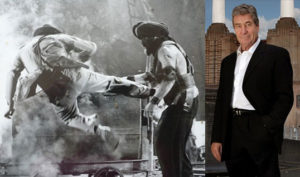

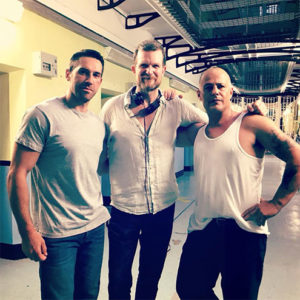
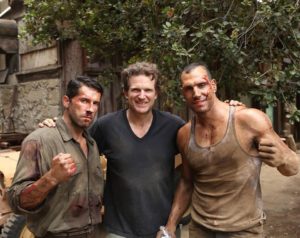
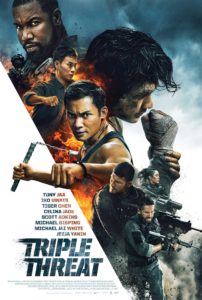


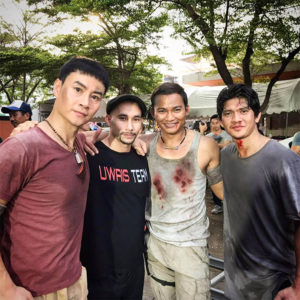
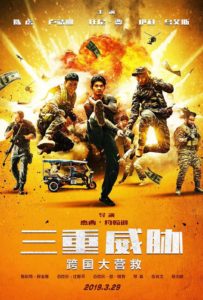
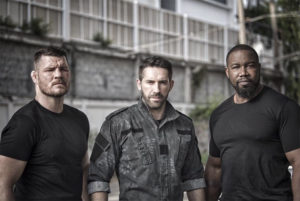
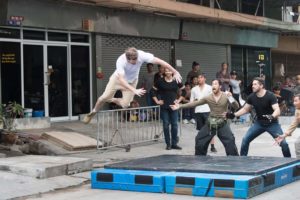

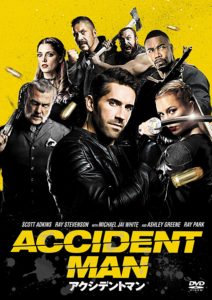

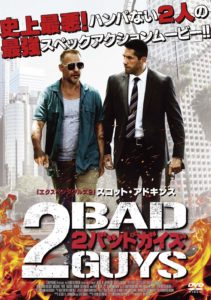

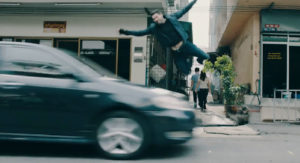
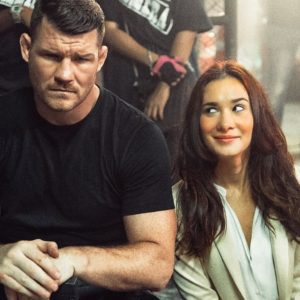
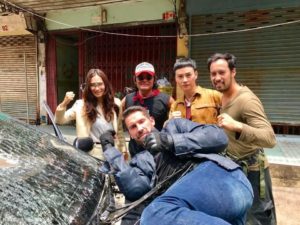

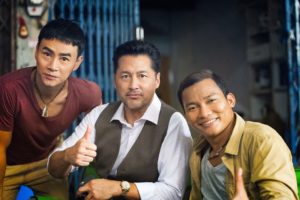
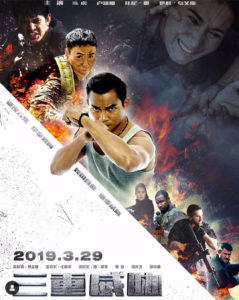



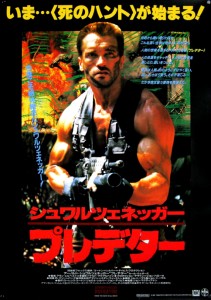
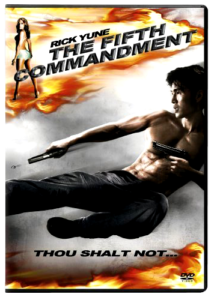
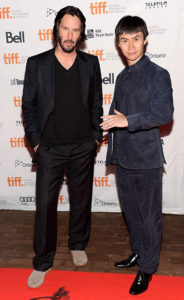
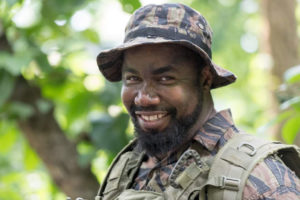
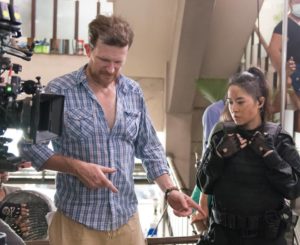
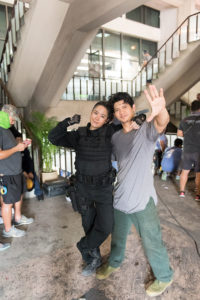
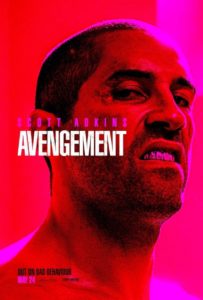



Great interview Paul!
Wow, incredibly meaty stuff here, a great interview for filmmakers to read too, plenty of valuable things to learn here, particularly in terms of finding success, maintaining it and keeping those irons in the fire.
Very good interview indeed. Avengement looks like a very violent Eastenders Christmas episode: bloodshed at the Old Vic.
Terrific interview, Paul. A really absorbing read and plenty of insight for up-and-coming action filmmakers. I saw ‘Triple Threat’ in theaters but it felt like less than stellar circumstances (the digital projection was not up to snuff – the film looked suspiciously low res), which I’m sure impacted my enjoyment of the movie. Reading this interview has me inspired to give it another shot via VOD.
Thank you Paul for this great great Interview!!!!
Thank you Paul for this amazing Interview!!!!
Thanks for the interview. Loved every sentence of it. I should be receiving my own press release of Triple Threat just today for a (German) review. Have been looking forward to watching the movie for a long time and surely will buy the BD afterwards. Jesse seems to be a very approachable and open person and it’s great to receive that many insights into the production. Reminds me a bit of Isaac Florentine.
What an insightful interview! Johnson really knows how to utilize what limitations face him in his films. I think back to Hard Target 2, and how Scott Adkins mentioned that the budget was cut down significantly, and the shooting schedule was too short. Those problems were apparent onscreen.
Even Boyka, one could tell that the movie was smaller scale compared to the previous films, and it’s amazing how it still managed to be good in spite of the quick shooting and lower budget.
Johnson knows how to utilize those barriers to a point where they’re not obvious onscreen. Considering how many films he’s done in a short span, I get the feeling he doesn’t sleep!
It’s funny how he mentioned Bronson and Eastern Promises with Avengement, because those films were exactly what I was thinking about with the trailer.
So the core audience play video games instead of watching movies? I do both, so they should too!
Fantastic interview, many thanks.
Jessie V Johnson is a director who deserves a lot more credit, he has made some fabulous films, Accident Man and Debt Collector were highlights last year and I hope Triple Threat is a big hit.
Looking forward to seeing it in the UK soon.
Fantastic interview Mr Bramhall, so much content I’ll need to read this a few times, just to digest it all.